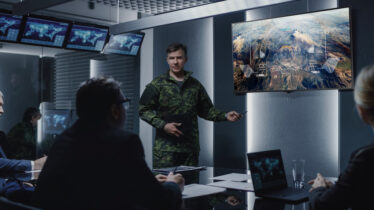Many digital innovations are helping federal IT managers transform government, but few are impacting agencies more than mobile technology. For example, the U.S. Census Bureau is stocking up with nearly a half-million handhelds for the 2020 census to capture data and verify addresses in the field.
While every agency may be at a different stage of maturity, organizations need to think beyond the basics and implement strategies that can truly transform the workplace and bring greater capability closer to the mission edge. However, mobile myopia keeps some organizations from seeing beyond on-the-go access to work email and calendars, which means lost opportunities for boosting productivity and serving constituents better. Case in point: smartphones yield an impressive productivity increase of 34 percent, according to a survey of 500 executives at U.S. government and commercial organizations conducted by Frost & Sullivan and underwritten by Samsung. The gains result from enabling closer collaboration among employees and an improvement in the quality of their work.
To unleash mobile’s potential, federal IT managers need a comprehensive mobile-first strategy. And getting there goes beyond technology — mobile needs to be a mindset that becomes ingrained in the agency culture. Here’s how to start.
1. Look to other agencies for inspiration. Inspection agents at the U.S. Department of Agriculture’s Animal and Plant Health Inspection Service significantly boosted their productivity with a smartphone application that facilitates information sharing and delivers real-time updates. The result: permitting time has shrunk from months to days, freeing agents to perform other high-value activities.
Our military is also tapping into advanced mobile capabilities to enhance readiness. The DoD, for example, is using virtual-, augmented- and mixed-reality to help fill the gap between classroom lessons and costly in-field training to drive mission preparedness wherever the troops are located. To develop the most realistic training possible, Samsung is partnering with leading content providers for interactive simulations that span weapons systems, combat operations, military health, maintenance training and more — before a boot ever hits the ground.
2. Assess your current mobile environment. Review which mobile devices and applications — and the workflow processes they support — connect to the agency’s networks. Be alert to shadow devices and applications that end users may be running without IT’s authorization. Use this baseline to launch discussions with department managers and end users to uncover gaps in mobile capabilities, embrace management solutions, and explore what new capabilities stakeholders will need to improve their work in the future.
3. Capitalize on the latest technologies. Match the resulting needs assessment with the latest mobility innovations to build on basics like email and calendars to more advanced applications for enhancing productivity. For example, government employees can pair their smartphones with the Samsung DeX platform to eliminate the need for a traditional PC, instead running virtualized Windows desktops and enterprise applications. This efficiently gives mobile users anytime access to all the agency data they’re authorized to see.
Digitize Your Government Agency
Get this guide to drive collaboration, boost productivity and ensure security in the public sector. Download Now
In addition, Samsung Galaxy smartphones and vehicle-mounted DeX stations give law enforcement agents and field workers a large screen to access their phone data in a more comfortable viewing format. Having a single device for data collection and processing can simplify access and eliminate the need to constantly switch from in-car technology to the field or a desk.
4. Balance usability and security. Senior managers are rightfully concerned about mobile security. Fifty-two percent of respondents to the Frost & Sullivan survey named data security a top concern. Agencies must mitigate these risks while also keeping security from dampening mobile’s potential for boosting productivity. To do this, they should use leading endpoint platforms that offer containerization for creating secure zones within mobile devices that clearly separate government and personal data and applications. And with the embedded Samsung Knox platform, agencies can get classified-grade security that relies on the hardware, not just the software, to protect data even when a device has been compromised.
5. Take the long view. A mobile-first strategy should embrace long-term trends, such as ongoing talent management. By 2030, millennials will comprise 75 percent of the workforce, and to compete for these workers, the federal government must stay innovative. That means staying up to date with mobility. As of the beginning of the year, 94 percent of adults between the ages of 19 and 29 owned a smartphone — versus 73 percent of those 50-64 years, according to the Pew Research Center. Just as telling is how millennials use mobile devices to communicate — they favor a wide range of apps, including those for video, audio and web conferencing.
Deploying the latest mobile technology and using it to transform how government operates will ensure a steady influx of new talent, while making agencies more productive and secure.
Get more details on how Samsung government solutions can help your agency establish a mobile device policy for today and tomorrow.








